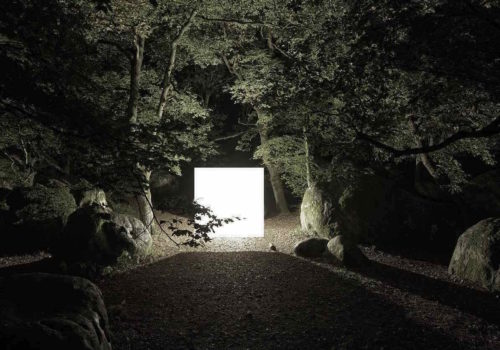Following on the heels of his work dealing with urban landscapes, including the series Entre Deux and City One, Vincent Fillon returns to Little Big Galerie with nocturnal images made deep in the woods. The exhibition is part of the network of the Circulation(s) Festival’s “associated venues.”
We were here plunges us into a dark forest, illuminated here and there by a halo, a shining cube, a fluorescent branch, or a ray of light, which underscore the poetic nature of the intertwined branches, of leaves trembling on the tree or dead on the ground, of a boulder or a footpath. With meticulous technical precision, the series suggests multiple layers of interpretation. At first approach, its romanticism grows darker the deeper one ventures into Vincent Fillon’s forest.
Where the element of light comes to dominate—bright, geometric, and clear-cut—the viewer’s attention turns to the human impact on nature: our capacity for appropriating the environment with man-made elements and applying our skills to the landscape. The artifact is a sign of the immemorial presence of humans who have, at best, tamed the wilderness or, more often than not, denatured it. This is the most obvious reading of these images.
Compositions, in which the source of light is evident, yet masked, prompt other interpretations. A sliver of light cutting across the face of a rock evokes the dawn of time, in a prehistoric vision populated with caves, fires, and early human shelters. Not being able to see where the light comes from brings to mind nearly extinct fragility, a search for shelter, a cave as the bedrock of architecture: there is already the choice of the space of refuge full of nooks and crannies and lookouts—the dweller’s hearing on high alert. Yet we know there is nothing tremulous or vacillating about this source of light. Its crispness, its whiteness, and its coldness evoke modern times and electricity. More than prehistory, is this a foreshadowing: of the end of the humankind? Of a handful of survivors of some untold catastrophe in search for cover?
If the nature of these lights wasn’t revealed in other photographs, we might just as well be looking at documentary images of a forest where twenty-first-century undocumented migrants or the dispossessed have found shelter in hope for better days. There is no longer a question of fleeing a natural disaster but rather of escaping police manhunts, political decisions, the excesses of the economy, and surveillance which are taking over our world. Yet without any trace of some hut or objects scattered about, there is no evidence for this contemporary prehistory. While there is every indication that the subject of the series is humans, they are painfully absent from the images. If some form of remembrance, mémoire des lieux, or trace of use seems in order, we can’t be sure this is what the images are about. The title, We were here, does suggest that we are dealing with the record of a presence.
The most mysterious photographs, where tangled branches come alive in strange light, are the most powerful. Following the slow architecture of Vincent Fillon’s trees at nighttime we recall Perrault’s or Grimm Brothers’ fairy tales. The forest looms large, tree trunks are a masterwork of architecture, the earth mirrors the sky. Our fantasies are childish, our imagination swarms with uncanny, fantastic figures, like Little Thumbling scattering breadcrumbs in his path, Hansel and Gretel and the gingerbread house, Little Red Riding Hood and her basket. The woods revert to their primal nature, become a potent, magical place where people feel humbled and enter discreetly. But it also the cradle, a source of nourishment, a refuge, an ecosystem where fauna and flora coexist in harmony. This is also where humans should find their rightful place.
From the vertical images of the soulless City One with its mad, repetitive, and oversized architecture, to the recent series N’habite plus à cette addresse [No longer at this address], to the palimpsests in Entre Deux [In between], Vincent Fillon continues to explore the place of humans and their impact on the environment. On this occasion, nature becomes a domain to be explored, architecture seems to have turned into a luminous object, and the forest is the focal point of the landscape, while the absent human figure morphs into the intangible presence of the artist behind his camera.
Fanny Léglise
Fanny Léglise is an architect and former deputy editor-in-chief of L’Architecture d’Aujourd’hui. A freelancer, she is a writer, picture researcher, and editorial consultant.
Vincent Fillon, We were here
January 26 to March 12, 2017
Little big Galerie
45, rue Lepic
75018 Paris
France
















